With the progressive generalization of the AIS (transceivers) aboard our pleasure boats (¹), and their obligatory presence on board a large proportion of commercial ships, capacities for display and processing of targets (surrounding vessels equipped with a transceiver) have significantly improved our security. Still need to know how to interpret this information that, in high-traffic areas, can quickly become a real headache.
The best navigation apps, just like the screens dedicated to AIS, are able to provide, not only display and progress of targets, but also the detailed information issued by them, and above all the data calculated in real time concerning the crossing with these targets and the risks of collision.
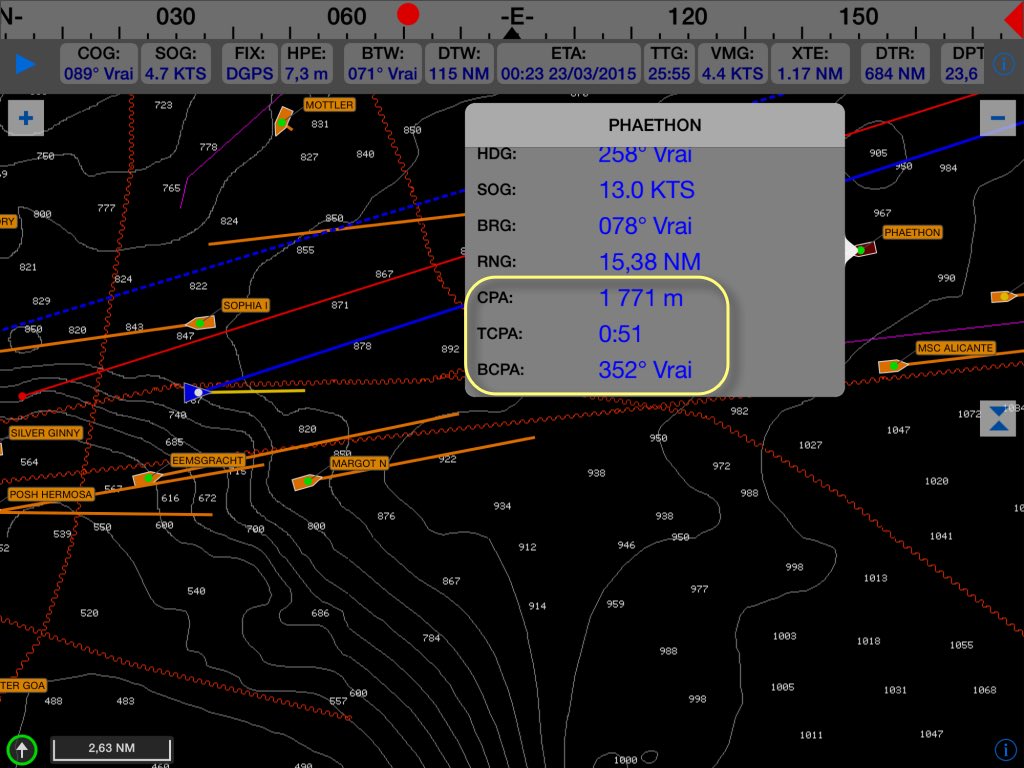
A drop-down window allows you to read all the data concerning a particular target. Here in night view.
From the route (COG) and speed (SOG) on the ground of a target, combined with the same data from our own ship, real-time calculation provides three essential pieces of information : CPA, TCPA and BCPA.
- CPA : Closest Point of Approach. Point where will occur the lowest distance of approach of a target, in other words the point where this vessel would come the more closely.
- TCPA : Time to Closest Point of Approach. The time remaining before reaching the CPA (in hours, minutes).
- BCPA : Bearing of Closest Point of Approach. The bearing of the CPA at the moment where it will happen.
These three pieces of information are inseparable. They will allow us to anticipate events and modify our route if necessary to avoid any risk of collision., and also avoid cutting too closely into the path of a larger, less maneuverable vessel.
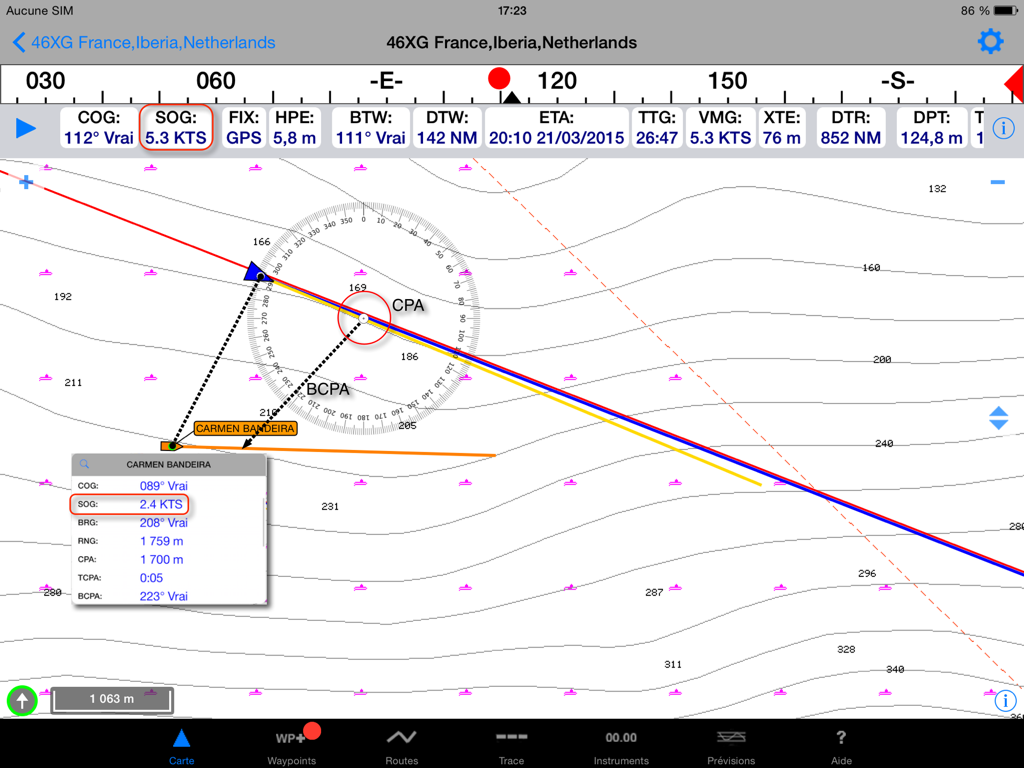 In the example above, the route of our boat will cross that of the target ship, le « Carmen Bandeira ». The respective velocity vectors are proportional to the speed over the ground for a specified period, 30 minutes in this example. This already allows at a glance to appreciate the respective speeds of the two ships., the one with the longest vector being the fastest. But that's not enough. The scrolling window activated on the target confirms its speed and route, and informs us in real time of its distance (RNG for Range), his bearing (BRG pour Bearing), you CPA, remaining time (TCPA) and bearing (BCPA) of target at the time of CPA. This last information is essential to know if the target will pass behind or in front of us., in addition to its distance.
In the example above, the route of our boat will cross that of the target ship, le « Carmen Bandeira ». The respective velocity vectors are proportional to the speed over the ground for a specified period, 30 minutes in this example. This already allows at a glance to appreciate the respective speeds of the two ships., the one with the longest vector being the fastest. But that's not enough. The scrolling window activated on the target confirms its speed and route, and informs us in real time of its distance (RNG for Range), his bearing (BRG pour Bearing), you CPA, remaining time (TCPA) and bearing (BCPA) of target at the time of CPA. This last information is essential to know if the target will pass behind or in front of us., in addition to its distance.
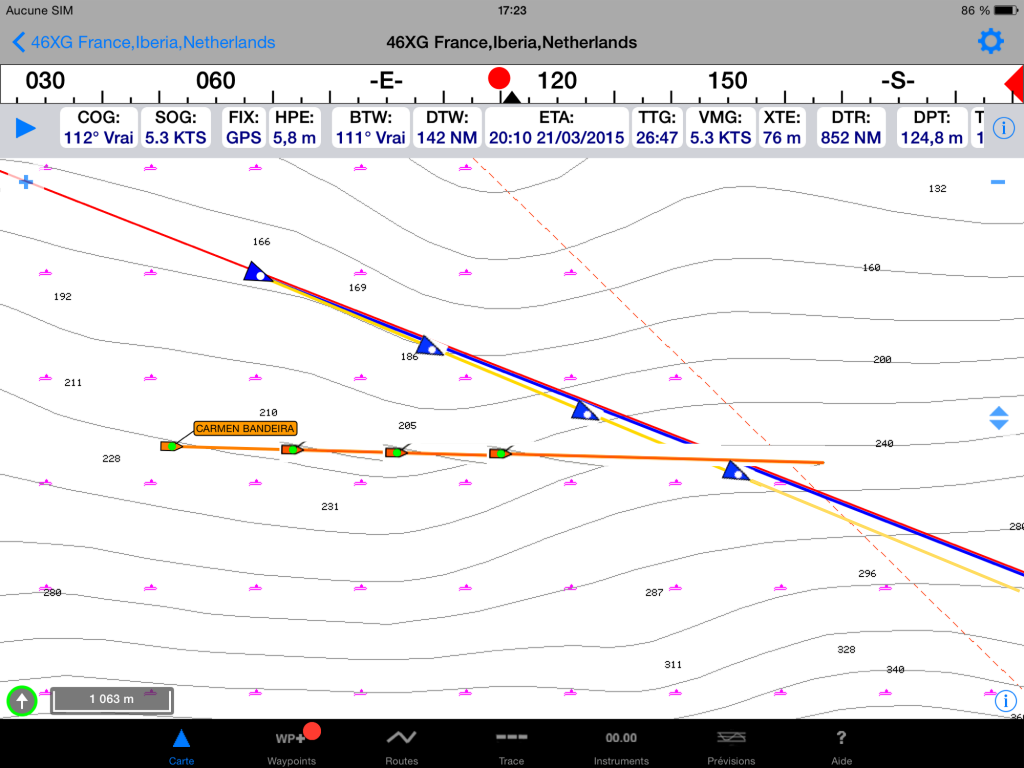 In the example above, if the target ship was much faster (let's say 15 knots) BCPA would probably have been of the order of 120°-130° and so the ship would come in front of us, presenting a lower risk. Due to its low speed, We are going to come ahead. We must ensure that we cut our route far enough ahead, and check frequently if its speed does not increase suddenly.
In the example above, if the target ship was much faster (let's say 15 knots) BCPA would probably have been of the order of 120°-130° and so the ship would come in front of us, presenting a lower risk. Due to its low speed, We are going to come ahead. We must ensure that we cut our route far enough ahead, and check frequently if its speed does not increase suddenly.
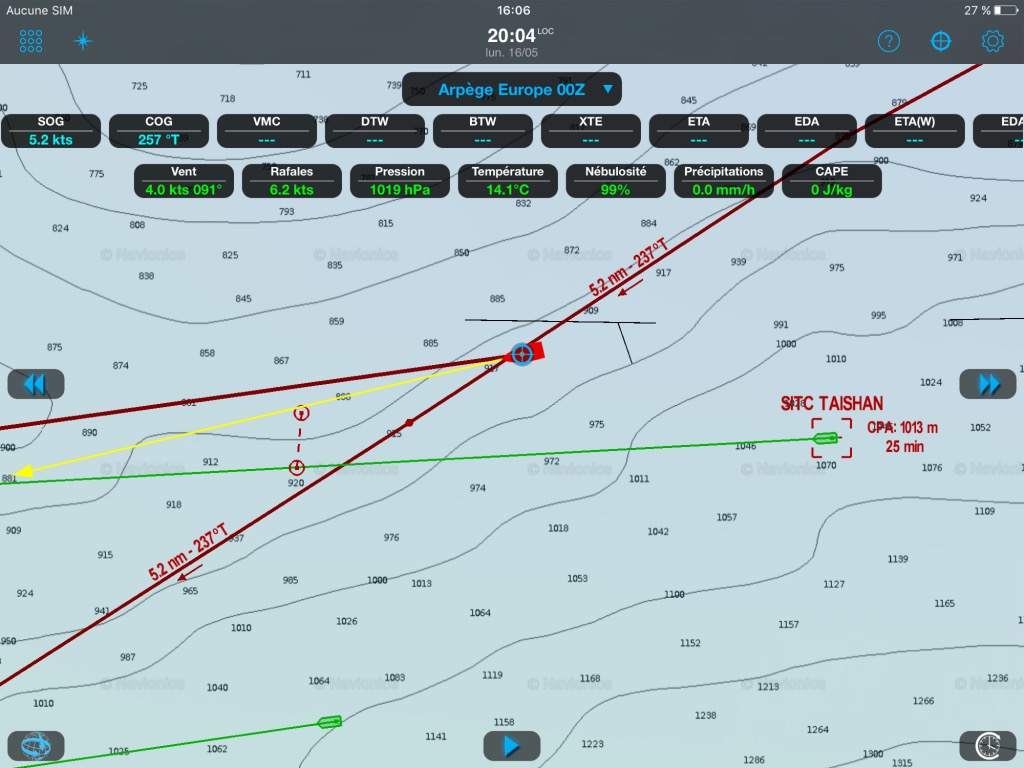
Weather4D Routing & Navigation indicates the prediction of positions at the time of CPA by two circles, taking into account ships GPS antenna location.
Avec Weather4D R&N above, you can activate several targets simultaneously to display the predictions calculated in real time. See also the capture at the beginning of the article.
In doubt, you should not hesitate to change your own route early enough, to make clear manoeuvre to the other ship, that also sees us on his own screen. The ship's route change is also generated by AIS transceiver, or calculated by navigation application : ROT data.
- ROT : Rate Of Turn. Ship's gyration rate, in degrees per minute, on port or starboard.
This data is particularly important for large tonnage ships which manoeuvre changes are very slow and may be imperceptible to the eye. The display on the chart or the screen of the ROT is usually done in the form of an arrow to port or starboard at the end of the velocity vector, in addition to the data displayed .
In all software and dedicated screens, alarms are adjustable for the CPA, TCPA or more simply a minimum distance from targets. But it provides nothing of a careful watch : all ships are not yet equipped with an AIS transceiver, or even sometimes switch it in "silent" mode, i.e. reception without transmission.
———
(¹) AIS, the second maritime revolution after the GPS
———

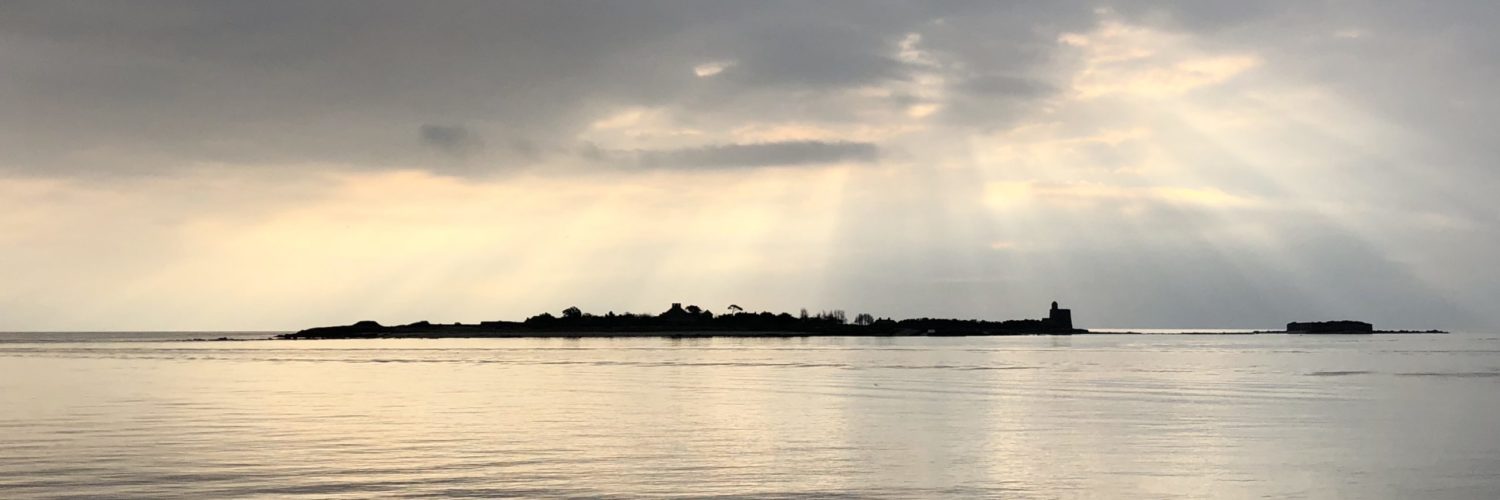
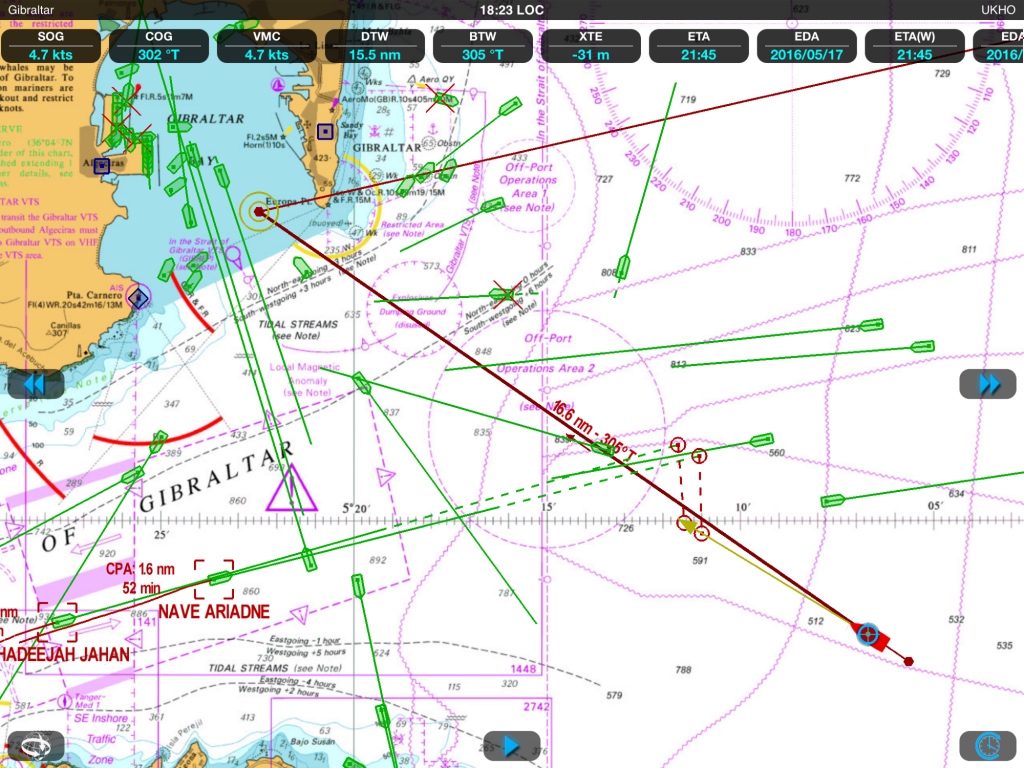
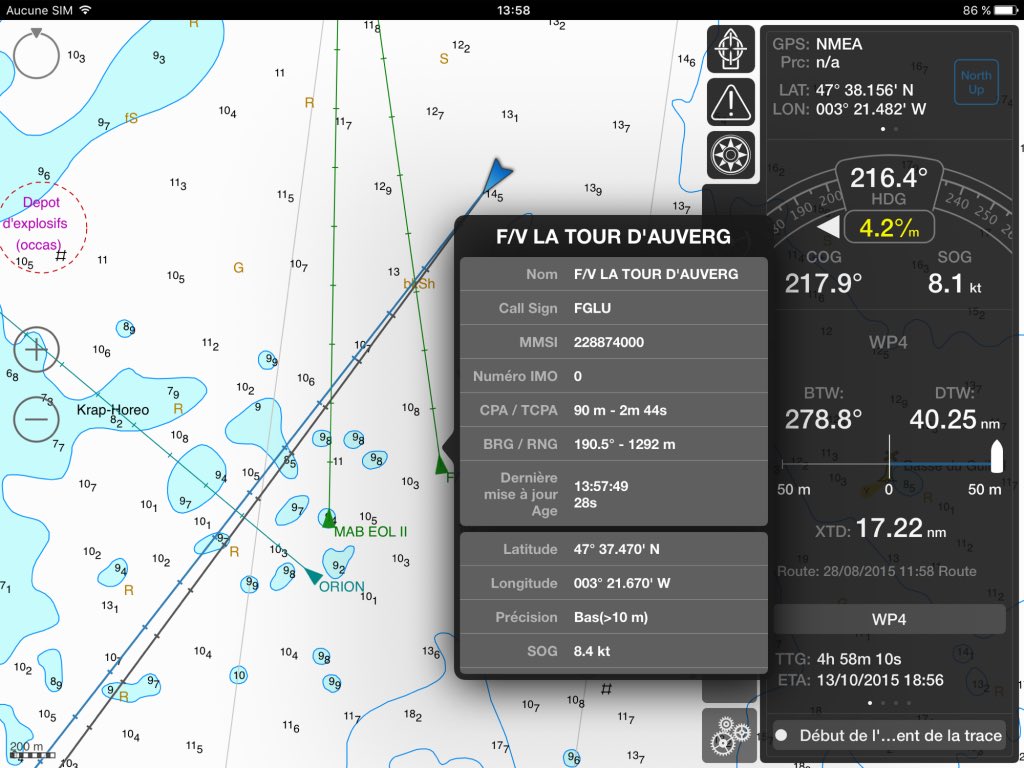
Thanks again Francis for this information. It must still be added that the Strait of Gibraltar, like La Manche, two of the busiest places in the world, have a descending corridor and an ascending corridor, we navigate to the right ! And that it is forbidden to cut these corridors diagonally but only in a perpendicular manner which visibly the 2 targets studied (Phaethon et Carmen Bandeira) do not respect ! Hence the interest of the AIS…
The Gibraltar rail does not begin, in the Eastern Strait of Gibraltar, that to the length of Algeciras. The example ships are therefore on a free navigation route. In my examples the “Phaethon” makes its way to position itself in the outgoing rail, the “Carmen Bandeira” has long left the incoming rail, just like our own boat.
Bonjour,
Good article, with just two detailed remarks : AIS transceivers are not transponders, to the extent that they transmit according to a rhythm defined by their class without being questioned, as are aeronautical transponders (military IFF, civil secondary radar) or radar SARTs. The corresponding word in English is the neologism “transceiver” and not “transponder”.
The TCPA is the time remaining before switching to the CPA, as you say very well, and should therefore be defined in English as “time to CPA”.
It would undoubtedly be useful to specify for boaters that the calculated CPA is often variable due to variations in route and speed due to the sea., to the wind and the quality of the helmsman of our small units, as well as the sometimes poor quality of the heading reference, this also applies to the use of ARPA or mini ARPA on pleasure radars.
Yours sincerely
The term “transponder” may be technically a misnomer, however it is used in French by a majority of manufacturers, reason why I took it back. For the rest I completely agree with you.